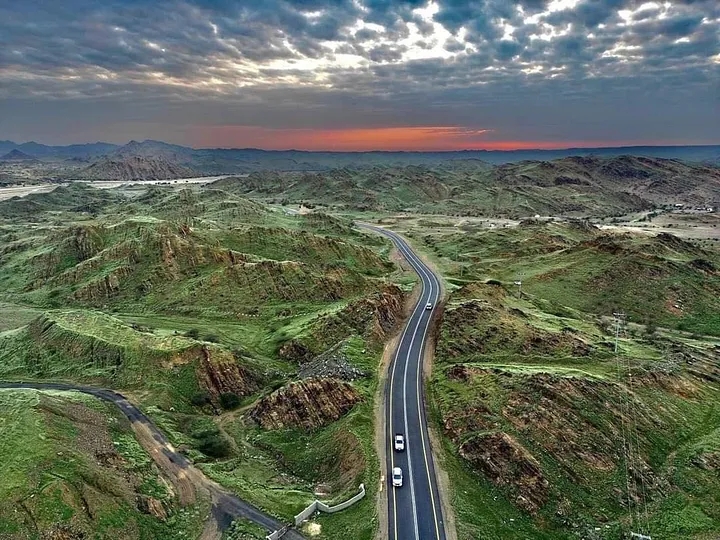From Arid to Lush: Exploring the Phenomenon of Saudi Arabia’s Desert Greeneries Amidst Increased Rainfall

In recent years, Saudi Arabia’s deserts have experienced a remarkable phenomenon – they’re turning green. The once barren landscapes, particularly between the holy cities of Mecca and Medina, are now adorned with lush patches of greenery, a stark contrast to their previous arid state. This transformation can be attributed to the increased rainfall that has blessed the region, providing much-needed moisture to the parched earth. Reports from Terra Satellite images on January 7 revealed the widespread presence of greenery in regions that were previously parched and barren. Internet users, initially startled by the prospect of such a dramatic change, soon found themselves in awe of the unexpected beauty unfolding before their eyes.
One of the most striking examples of this greening effect can be witnessed near the city of Medina, where Mount Uhud, a significant landmark in Islamic history, has been graced with the unexpected appearance of a waterfall following heavy rains. This extraordinary sight has captured the attention of locals and visitors alike, serving as a powerful symbol of nature’s resilience and adaptability.
The impact of the rainfall is not limited to Mount Uhud; it extends across vast expanses of desert terrain, breathing new life into the once barren landscapes. The transformation is particularly pronounced in the western regions of Saudi Arabia, where the infusion of water has sparked the growth of vibrant flora, turning swathes of sand into verdant oases.
The images and videos depicting the stark contrast between arid and green regions continue to circulate on the internet, sparking discussions and speculation. Some have even drawn parallels to prophetic statements attributed to the Prophet of Islam, suggesting that the appearance of greenery in the desert may be a sign of the fulfillment of Islamic prophecy. The Prophet Muhammad (peace be upon him) prophesied that “The Hour will not come until Arabia returns to being pasture and rivers.” [Source: Sahih Muslim 157c, Book 12, Hadith 76]. For Muslims, the fulfillment of this prophecy is seen as a sign of the approaching end times and a testament to the truth of the Prophet’s message.
Archaeological discoveries further fuel this speculation, with fossils such as elephant tusks unearthed decades ago indicating that Saudi Arabia was once a lush wetland teeming with life. The juxtaposition of ancient relics and modern-day miracles adds depth to the narrative, inviting contemplation on the cyclical nature of history and the resilience of the natural world.
Climate change is a global phenomenon with far-reaching implications for the planet’s ecosystems and human societies. One of the most alarming manifestations of this phenomenon is the transformation of once-green landscapes into arid deserts, a trend observed in various parts of the world, including the United States. Areas that were historically characterized by lush vegetation and fertile soil are now experiencing desertification, as rising temperatures and changing precipitation patterns disrupt traditional ecosystems.
In the southwestern United States, states like California and Arizona are grappling with the effects of prolonged droughts and dwindling water resources. The iconic landscapes of the American West, known for their rugged beauty and abundance of flora and fauna, are facing unprecedented challenges as water scarcity intensifies and temperatures soar. From the vast expanses of the Mojave Desert to the fertile valleys of the Central Valley, signs of desertification are becoming increasingly evident, posing significant challenges for agriculture, wildlife, and human communities.
However, amidst the wonder and speculation, there are voices of concern and skepticism. Pilgrims visiting Mecca were surprised by the sudden greenery in the holy cities, prompting mixed reactions. While some marveled at the beauty of the transformed landscapes, others expressed unease, interpreting the phenomenon as a potential sign of the nearing Last Hour. In response to both the wonder and the worry, the Saudi Green Initiative has been launched, with ambitious goals to restore and expand natural greenery across the kingdom. With 17 new initiatives underway and millions of trees already planted, the vision of a Green Saudi Arabia by 2030 is gradually taking shape. This concerted effort to nurture and protect the environment underscores the kingdom’s commitment to sustainable development and the preservation of its natural heritage for generations to come.
The greening of Saudi Arabia’s deserts is not an isolated occurrence but part of a larger trend observed across the region. In neighboring countries like the United Arab Emirates, recent storms have unleashed unprecedented levels of rainfall, with one storm dumping the heaviest rain ever recorded in the country’s history. These events underscore the complex interplay between climate patterns and environmental dynamics, highlighting the need for continued research and conservation efforts to mitigate the impacts of climate change on fragile ecosystems.
Join our newsletter







Leave a comment